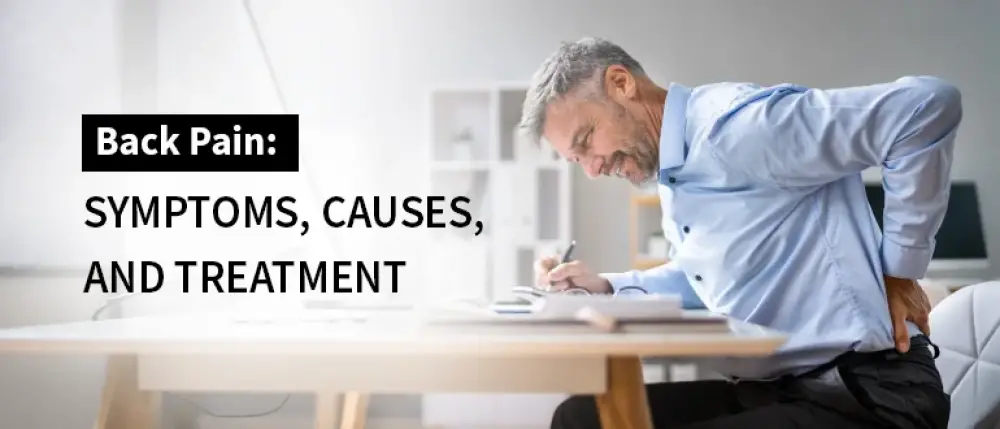Subscribe to get weekly insights
Always stay up to date with our newest articles sent direct to your inbox
Published on 29 Nov, 2023
Updated on 22 Aug, 2025
19760 Views
5 min Read

Written by Jagriti Chakraborty
Reviewed by Ritika Malik
favorite4Likes
Back bone pain is something many of us have experienced at some point. It's that uncomfortable feeling or even sharp pain in your back, whether it's in the lower, middle, or upper part of your back. It can range from being a minor annoyance that comes and goes to a more persistent and severe discomfort.
The causes of back pain can vary, from simple things like straining your muscles to more complex issues like herniated discs or underlying medical conditions. Back pain can affect how you move, do your daily tasks, and even your overall well-being. Let’s discuss more about back pain in detail.
Let us take a look at some of the most common back pain symptoms:
When it comes to categorising back pain, medical experts and researchers break it down into several distinct types:
This type of back pain strikes suddenly and typically lingers for a brief period, ranging from a few days to a few weeks.
Subacute back pain can either emerge suddenly or develop gradually over time. It tends to persist for a duration of 4 to 12 weeks.
Chronic back pain can manifest abruptly or progress slowly, and it endures for more than 12 weeks. In this category, pain becomes a daily presence in one's life.
The anatomy comprises four distinct regions:
Back pain arises seemingly without a clear cause, which can be pinpointed through tests or imaging studies. Some prevalent conditions associated with back pain are:
Activities like repetitive heavy lifting and sudden awkward movements can strain the muscles in your back and the ligaments that support your spine. Individuals with lower physical fitness may experience muscle spasms due to continuous back strain.
The discs function as padding between the vertebrae in your spinal column. Occasionally, the inner soft material of a disc can protrude or burst, applying pressure to a nerve. Curiously, the occurrence of a bulging or ruptured disc may not always result in back pain. It is often discovered incidentally during spine CT scans, X-rays, or MRIs conducted for unrelated back pain reasons.
Osteoarthritis or Arthritis can cause pain in the lower back, and in certain cases, it can result in the constriction of the space surrounding the spinal cord, a medical condition referred to as spinal stenosis.
It is an inflammatory disease that causes fusion in some spine's bones, reducing its flexibility and leading to discomfort.
When the bones in the spine become porous or brittle, they can develop painful fractures, contributing to back pain.
Here are steps to help alleviate severe lower back pain:
Here are common treatments for back pain:
Over-the-counter pain relievers or non-steroidal anti-inflammatory drugs (NSAIDs) can be helpful in relieving pain. In some cases, medications that relax muscles and prevent spasms may be prescribed.
PT plays a crucial role in strengthening the muscles that support your spine. It not only enhances muscle strength but also improves flexibility, reducing the risk of future injuries.
Various manual therapies can help alleviate lower back pain, relax tight muscles, and improve posture and alignment. Depending on your specific condition, you might benefit from treatments like osteopathic manipulation, chiropractic adjustments, or even massage therapy to relieve pain and restore function.
In certain situations, your healthcare provider may recommend injections. These involve using a needle to deliver medication directly to the source of the pain. Steroid injections can be particularly effective in reducing pain and inflammation.
When injuries or conditions necessitate surgical intervention, there are several surgical techniques available for treating lower back pain. Many minimally invasive procedures are also options, depending on your diagnosis and the severity of your condition.
>> Also Read: Reasons Why You Get a Recurring Back Pain
Taking care of the body is crucial for a pain-free life. Simple lifestyle changes like proper posture and regular exercise can make a big difference. Sometimes, medicines or home remedies may not relieve extreme back pain. When back pain worsens, it can lead to the need for surgery. Thus, having health insurance becomes a vital safety net. It ensures you can access the medical care you need without worrying about the financial burden.
With Care Health Insurance, you can choose between a number of healthcare plans. Spend some time to chalk out your needs and pick a plan that best suits your preferences and your budget. Invest in your health and consider the importance of a reliable health insurance plan to safeguard your well-being.
Disclaimers:
1. The above information is for reference purposes only: Policy Assurance and Claims at the underwriter's discretion.
2. All plan features, benefits, coverage, and claims underwriting are subject to policy terms and conditions. Kindly refer to the brochure, sales prospectus, and policy documents carefully.
Thyroid : मामूली नहीं हैं महिलाओं में थायराइड होना, जानें इसके लक्षण और घरेलू उपचार Vipul Tiwary in Diseases
शुगर कंट्रोल कैसे करे? जानें, डायबिटीज में क्या खाना चाहिए Vipul Tiwary in Health & Wellness
हाई ब्लड प्रेशर को तुरंत कंट्रोल कैसे करें? देखें इसके उपाय Vipul Tiwary in Diseases
पैरों में दर्द किस कमी से होता है? जानें, इसके घरेलू इलाज Vipul Tiwary in Health Insurance Articles
Amino Acids: The Unsung Heroes of Your Mental Well-being Jagriti Chakraborty in Mental Health
8 Reasons to Start Your Morning with Ajwain Water Jagriti Chakraborty in Home Remedies
Ice Water Face Dip: The 15-Second Beauty Hacks Celebs Swear By Jagriti Chakraborty in Home Remedies
Struggling with Gluten? It Might Be Celiac Disease Jagriti Chakraborty in Diseases
Always stay up to date with our newest articles sent direct to your inbox
Loading...